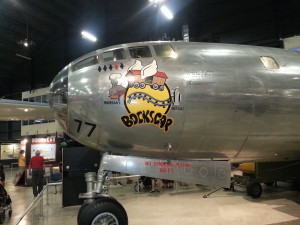I suppose it’s embarrassing that I have to use that post title. Yeah, yeah, I know: If you’re not outraged you’re not paying attention. Nonetheless in looking back at many, if not most, of the posts I’ve put up over the years, I have to acknowledge that levity and good feelings are comparative strangers around here.
Today I make an exception.
Over Labor Day weekend the family and I hied us to the National Museum of the U.S. Air Force, located at Wright-Patterson Air Force Base in Dayton, Ohio. It’s easy to get to, it has free parking and admission, and oh by the way, did I mention it rocks? We spent Saturday afternoon, most of Sunday, and Monday morning there. If that’s all you did you should still budget at least two full days if you want to see everything they have, and read all the explanatory material, and actually spend some time contemplating the exhibits, rather than just rushing on towards the next one.
The museum is set up in gigantic (I mean, like, really enormous . . . like multiple football field big) hangar-like buildings, each connected to the next via covered (and mercifully air-conditioned) passageways. The most interesting exhibits are at floor level, although they also have many suspended above you, chiefly the (for me, at least) less interesting ones, like drones, air-launched missiles, small trainer and transport aircraft, and so forth. The exception to the pattern is the exhibit hall for the ICBMs, which is set up to remind the visitor of a missile silo (round and very, very tall). Obviously, most of the exhibits are United States warbirds, although they do have quite a number of German, several Japanese, and a few Soviet exhibits. They’ve got a V-1 and a V-2, a Bf-109, MiG 15, MiG-29, etc. Interesting stuff.
What they don’t have very much of is — with the exception of one specific exhibit hall, on which more later — individually historical aircraft, by which I mean specific airplanes that in and of themselves are historically significant. By way of counter-example, the National Naval Aviation Museum, located at NAS Pensacola (and itself likewise worth the trip from wherever Gentle Reader might be) has the only known survivor of both Pearl Harbor and Midway; it has the NC-4 (the first airplane to fly the Atlantic); it has quite a bit of the bridge equipment from USS Enterprise (trivia note: the chap who founded Enterprise Rent-a-Car served in her during the war, and named his company after his ship), and so forth. I can understand that: Most of the historically significant land aircraft are going to be found at the Smithsonian, so the Air Force Museum is going to have to take second pick. Illustrating that literally is the fact that Enola Gay, the airplane that dropped the first atomic bomb, on Hiroshima, is in the Smithsonian. Bockscar, which dropped the second bomb, on Nagasaki, is in Dayton, viz:
The major exception to the above pattern is the presidential gallery, in which they have a fistful of airplanes which served different presidents. They have, for example, the last of the several airplanes nicknamed Sacred Cow, which ferried Roosevelt to the Yalta Conference. It was a built-out C-54 and featured an elevator mounted in its tail to hoist FDR aboard in his wheelchair.
They also have the airplane which brought Kennedy’s body back from Dallas. Not wanting to shove his casket into the cargo hold, they sawed out a chunk of an aft bulkhead and wedged him in that way, with his widow making the trip sitting in a seat opposite. They’ve got Truman’s plane, the Independence, as well as several smaller airplanes which served in different roles. What they don’t have is a Marine One, which is understandable, it being Navy (you can see one at the Naval Aviation Museum if so inclined). The presidential exhibit shares an off-site (for the time being; starting at the end of the month they’re going to move both to the main facility) hangar with their collection of experimental aircraft. They’ve got the only surviving XB-70 (the other one crashed during test flight), the prototype of the XF-23, the competitor which lost out to what became the F-22 Raptor, and a raft of other things some of which you have a hard time imagining in the air.
What struck me — and here I am perhaps betraying an ignorance born of sloth — is the sheer variety of aircraft the U.S. has put into the air over the years. Sure, everyone’s heard of the B-52, the B-24, the B-1, the P-47, the F-4 Phantom, and so forth. But how about the RB-47, or the A-20? Or the B-50 Hustler? To say nothing of the inter-war aircraft? The Air Force Museum has got ’em all. Among the most impressive for me was the B-36 strategic bomber. Again, although I’d heard of this one, I’d never really paid attention to it, considering it to be one of those stop-gap planes that we just shoved onto the flight line until we could get the B-52 in the air. Well, it was our principal strategic weapons platform for most of the 1950s, and man alive! is it huge. It’s got ten — count ’em — engines: six pusher propellers and four jet engines mounted in twin pods outboard of the props. And did I mention the thing’s ginormous?
As with any exhibit of historical artifacts, you get a sensation of times which were in important ways profoundly different from our own. F’rintsance, you kind of get a notion that the concept of “micro-aggression” hadn’t made it into the lexicon of the U.S. Army Air Force when you take a look at the nose art on their B-24 Liberator:
Around the walls of the exhibition halls, as well as interspersed among the airplanes, they’ve got thematic exhibits of documents, artifacts, and so forth. Some of them are personal to specific aviators, who either died in combat or who otherwise were of significance. There are POW exhibits for both World War II and Vietnam. There are exhibits on the strategic bombing campaigns over both Europe and Japan. One omission I found interesting is the complete absence of any mention of Dresden. They do have a small mention of the fire-bombing raid on Tokyo, which actually killed quite a number more than the raid on Dresden did. I wonder if that’s because Dresden was principally an RAF Bomber Command show, with the 8th Air Force showing up the following morning to make the (burning) rubble bounce.
The museum also has an IMAX movie theater. I didn’t go to see either of the two movies they were showing (one on D-Day and the other I forget what). If you were to do that you’d need to budget additional time accordingly.
The passageways between the main exhibit halls are not wasted, either. In one they have an exhibit on the Holocaust, including a listing of people in the Dayton area who either were survivors, or liberators, or who have been inducted into Yad Vashem as Righteous Among the Nations. In another passageway there’s a really well-done exhibit on the Berlin Airlift, and in a third a collection of bomber jacket art. In another area they have a really cool exhibit, complete with video, on Bob Hope and his 50-plus years of touring to take the troops’ minds off their troubles, even if only for a few moments.
All in all, it’s a wonderful time and I can’t recommend it too highly.



